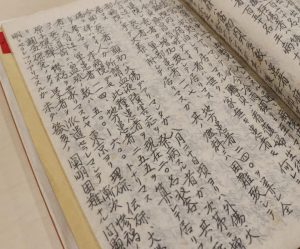Documenting Hiroshima of 1945: Around August 20, blood disorders also observed at Red Cross Hospital
Aug. 22, 2024
by Maho Yamamoto, Staff Writer
The Hiroshima Red Cross Hospital (present-day Hiroshima Red Cross Hospital & Atomic-bomb Survivors Hospital, in Naka Ward), located in central Hiroshima City, was flooded with survivors of the atomic bombing seeking treatment. Around August 20, 1945, a change occurred in symptoms experienced by patients.
“Starting around August 20, an increasing number of people without external injuries or burns were gradually developing so-called blood disorders.” That entry was included in the General Situation Report (stored at the Imperial Household Archives) under the name of the hospital’s director Ken Takeuchi, who died in 1974 at the age of 84. The report was compiled in time for the arrival of Chamberlain Torahiko Nagazumi, who was dispatched by the Showa Emperor to Hiroshima on September 3.
Patients were showing a dramatic reduction in number of white blood cells, which function to protect the body from pathogens. A normal count is considered to be between 4,000 and 9,000 such cells per one cubic millimeter of blood. However, according to the report, “the white blood cell counts of patients dropped to between 500 and 600 just prior to death.” The number of deaths involving blood diseases reached 369 people in that period up to September 3.
At the hospital, a survey team dispatched by the Imperial General Headquarters, which included Dr. Yoshio Nishina, an atomic physicist, confirmed that X-ray film had been exposed to A-bomb radiation. The report explained the exposure of the X-ray film and stated that A-bomb radiation could have been a reason for the blood disorders. Decreased white blood cell counts were observed not only in patients but also hospital staff who experienced the atomic bombing, with the report indicating that, “From a medical point of view, hospital staff were also physically affected.”
On the other hand, whether or not there were any impacts from residual radiation was also a major concern. In Mr. Takeuchi’s notebook at the time, his scribbled notes read “unhealthy areas” (in an entry dated August 22) and “unhealthy areas (from uranium)” (August 30). The medical personnel, tasked with saving the lives of others, also suffered negative effects to their health, with safety even in a medical environment threatened. Despite experiencing damage from inhumane radiation, however, they continued their relief work.
(Originally published on August 22, 2024)
The Hiroshima Red Cross Hospital (present-day Hiroshima Red Cross Hospital & Atomic-bomb Survivors Hospital, in Naka Ward), located in central Hiroshima City, was flooded with survivors of the atomic bombing seeking treatment. Around August 20, 1945, a change occurred in symptoms experienced by patients.
“Starting around August 20, an increasing number of people without external injuries or burns were gradually developing so-called blood disorders.” That entry was included in the General Situation Report (stored at the Imperial Household Archives) under the name of the hospital’s director Ken Takeuchi, who died in 1974 at the age of 84. The report was compiled in time for the arrival of Chamberlain Torahiko Nagazumi, who was dispatched by the Showa Emperor to Hiroshima on September 3.
Patients were showing a dramatic reduction in number of white blood cells, which function to protect the body from pathogens. A normal count is considered to be between 4,000 and 9,000 such cells per one cubic millimeter of blood. However, according to the report, “the white blood cell counts of patients dropped to between 500 and 600 just prior to death.” The number of deaths involving blood diseases reached 369 people in that period up to September 3.
At the hospital, a survey team dispatched by the Imperial General Headquarters, which included Dr. Yoshio Nishina, an atomic physicist, confirmed that X-ray film had been exposed to A-bomb radiation. The report explained the exposure of the X-ray film and stated that A-bomb radiation could have been a reason for the blood disorders. Decreased white blood cell counts were observed not only in patients but also hospital staff who experienced the atomic bombing, with the report indicating that, “From a medical point of view, hospital staff were also physically affected.”
On the other hand, whether or not there were any impacts from residual radiation was also a major concern. In Mr. Takeuchi’s notebook at the time, his scribbled notes read “unhealthy areas” (in an entry dated August 22) and “unhealthy areas (from uranium)” (August 30). The medical personnel, tasked with saving the lives of others, also suffered negative effects to their health, with safety even in a medical environment threatened. Despite experiencing damage from inhumane radiation, however, they continued their relief work.
(Originally published on August 22, 2024)








